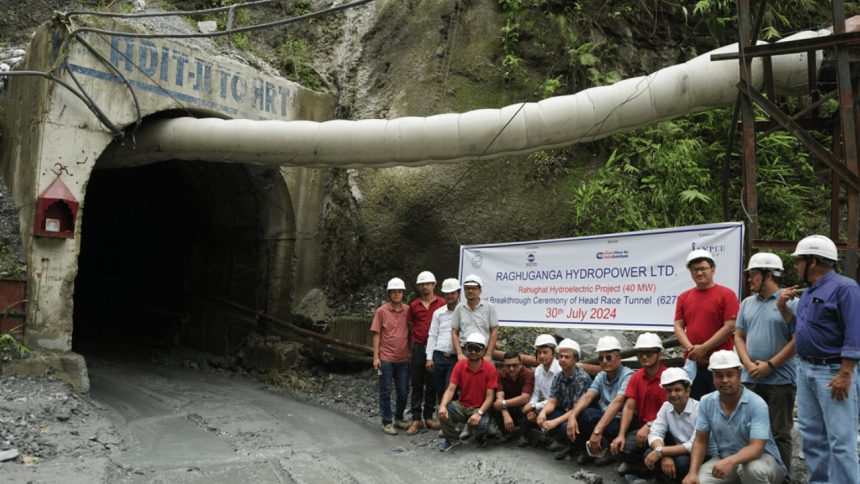The Rahughat Hydropower Project is a mega energy development project located in the Myagdi district of Gandaki Province, Nepal. This particular project reflects the commitment of the country toward the generation of sustainable energy, for it envisions harnessing the energy of the Raghuganga River. This peaking run-of-river scheme has been planned for implementation in order to make a significant contribution to the supply of Nepal’s electricity with its associated economic and environmental benefits.
After fourteen years of development, the 40-megawatt Rahughat Hydropower Project has reached 60 percent of completion. Initially It was launched in the year 2066 BS by the Nepal Electricity Authority. It was financed with a $67 million concessional loan from Exim Bank, the Export-Import Bank of India, with joint investment from the NEA and the Government of Nepal.
The project suffered a major setback in 2072 BS with the termination of the contract with the original contractor, IVRCL, due to financial instability. Thereafter, construction resumed under a new EPC model. The project was first targeted for its completion in the year 2070 BS. The civil contractor Jaiprakash Associate stepped in with a Rs 6 billion contract to complete the same by 2074 BS. But the project has failed to meet any of its initial completion deadlines.
According to Project Manager Raj Bista, it has now covered 60 percent in physical and 45 percent in financial progress.
“We are targeting to come into operation by January 2023. However, due to the COVID-19 and other issues, the contract was extended until October 17, 2024,” said Bista.
The earlier contractor, IVRCL, had completed only 10 percent of the work in eight years. Since it took over, JP Company has done considerable work: a surge shaft measuring 61 meters in depth, a bottom pressure shaft of 329 meters, a 654-meter-long access roads that lead to the main tunnel, and a vertical tunnel of 196 meters.
Out of the projected 6.27 kilometers of the tunnel, already excavated are 5.162 km, while those still to be excavated are 1.108 km.
Project Location
The Rahughat Hydropower Project is strategically located in the Raghuganga Rural Municipality within the Myagdi district. The intake site is positioned at Jhi in Ward No. 05, while the powerhouse is situated in Tilkanya, Ward No. 03 of the same municipality.
General Project Features
The Rahughat Hydropower Project is centred on the Raghuganga River, with its closest town being Beni. It is a peaking run-of-river scheme, and it maximizes the generation of energy at times of peak demand. Gross head is 292.83 meters, while net rated head is 281.56 meters. The installed capacity for this project is 40 MW, with two units each of 20 MW capacity. The annual average energy output from the project shall be around 238.59 GWh, including 27.95 GWh of peak energy, 50.26 GWh of off-peak energy, and 160.37 GWh of wet energy.
Drainage Area and Flow Characteristics
The total drainage area of the project covers 305.0 square kilometers, with an effective area of 287.0 square kilometers located below 5000 meters. The 90% firm flow in the driest month is measured at 6.13 cubic meters per second (m3/s), while the design flow stands at 16.67 m/s. These flow characteristics are crucial for the efficient operation of the hydropower plant, particularly during the dry season.
Diversion During Construction
To facilitate the construction of the Rahughat Hydropower Project, a diversion channel has been implemented. This channel is designed to handle a flow of 27.0 m/s, accommodating dry season flows with a recurrence interval of 1 in 10 years. The diversion structure ensures the smooth continuation of construction activities without disrupting the natural flow of the river.
Reservoir and Barrage Specifications
The reservoir associated with the project has a full supply level of 1,165.0 meters, whereas the minimum operating level is 1,160.0 meters; there has further been a maximum flood level set at 1,166.10 meters to ensure the safety and stability during extreme weather conditions. The barrage is a gated structure, as is the undersluice, whereas the deck level is pegged at 1,169.0 meters, and the elevation of the spillway crest is 1,157.0 meters. Maximum height of barrage above foundation 25.5 m Length of Crest 21.0 m In this way, the height would be sufficient to carry the maximum design discharge of 688.0 m/s furnish, and would be ensuring resiliency of the project in floods.
Desander and Headrace Tunnel
The project incorporates a desander with two bays, all designed to catch particles larger than 0.20 mm. Each bay is 80.0 meters long, 8.0 meters wide, and 5.94 meters deep; in this way, it ensures that sediment is removed before water enters the headrace tunnel. The concrete-lined headrace tunnel is 6,270.106 meters long, with an internal diameter of 3.30 meters. The tunnel features a horseshoe shape with D-shaped excavation and lining of variable thickness ranging from 300.0 to 350.0 mm to guarantee the structural integrity of its shape for efficient flow of water.
Surge Shaft and Butterfly Valve Chamber
A surge shaft with a diameter of 10.0 meters and a height of 53.15 meters is included in the project design to manage water pressure variations. The maximum upsurge level is 1,178.42 meters, while the minimum down surge level is 1,142.33 meters. The butterfly valve chamber, with finished dimensions of 10 meters in length, 10 meters in height, and 6 meters in width, plays a crucial role in regulating water flow and ensuring safety during operation.
Steel-Lined Pressure Shaft and Powerhouse
The steel-lined pressure shaft has a diameter of 2.15 meters and a length of 53.15 meters, with the shell thickness varying from 10 to 25 mm. After bifurcation, the penstock diameter reduces to 1.52 meters, with each section measuring 20.0 meters in length. The powerhouse, measuring 57 meters in length and 24 meters in width, houses two Pelton turbines with a vertical axis orientation. Each turbine has a rated flow of 8.34 m/s and a rated capacity of 20.51 MW, complemented by generators with a rated capacity of 23.53 MVA. The turbines and generators boast high efficiency, with the turbines operating at 90.50% efficiency and the generators at 97.50%.
Transmission Line and Access Road
The Rahughat Hydropower Project includes a 132 kV transmission line, which involves the LILO (Line In Line Out) of a 220 kV transmission line from Dana to Kushma at the powerhouse gantry. The total length of the transmission line is 600 meters, ensuring efficient energy distribution. Additionally, a new permanent access road, stretching 10.87 km from the powerhouse to the headworks, has been constructed. A 0.8 km branch road to the adits is also part of the infrastructure development, facilitating easy access to the project site.
Economic Indicators
The Rahughat Hydropower Project, excluding the transmission line, has a project cost of NPR 859.89 crore. The total annual energy output is estimated at 247.89 GWh, with firm energy (90% hydrological firm) accounting for 137.71 GWh and secondary energy contributing 110.18 GWh. The benefit/cost ratio at a 10% discount rate stands at 1.09, indicating a favourable economic return on investment.
Conclusion
The Rahughat Hydropower Project is very important for Nepal’s energy needs. It is located in a key area and uses modern engineering to produce electricity in an efficient way. As the demand for electricity keeps increasing in the region, this project will help meet those needs. Besides just providing power, the project also pays attention to the environment, making sure that it is protected. This focus on cleaner and sustainable energy makes the Rahughat Hydropower Project a vital step forward for Nepal’s future.









